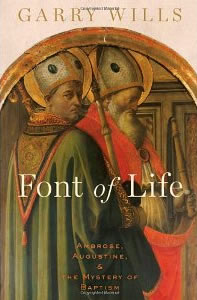Book Notes
 Garry Wills, Font of Life; Ambrose, Augustine, and the Mystery of Baptism (New York: Oxford University Press, 2012), 194pp.
Garry Wills, Font of Life; Ambrose, Augustine, and the Mystery of Baptism (New York: Oxford University Press, 2012), 194pp.
Most people who visit the Milan Cathedral, which dates to 1386 and is the fourth largest cathedral in the world, head to the roof top where they enjoy a bird's eye view of the city. When Garry Wills visited, he went down through a little known entrance that leads underneath the church to a sunken cathedral and baptistry beneath the piazza. This subterranean church was discovered by accident in 1943 by workers who were digging a bomb shelter during the war. It was later determined that this massive edifice, which held three thousand people, was built in the middle of the fourth century and pastored by the great bishop Ambrose of Milan.
Next to the underground basilica is an octagonal building containing a baptistry pool twenty feet in diameter. This is probably where Ambrose himself was baptized in the year 374. And it's most certainly where on Easter morning, April 25 in the year 387, that the thirty-three-year-old St. Augustine was baptized by Ambrose, an event that foreshadowed so much of western Christianity. This symbolic site is archaeological grist for the theological mill of Garry Wills. As he does in all his many books, he brings a prodigious amount of linguistic, historical, and bibliographical scholarship to the task.
The first part of this short book considers Ambrose, bishop of Milan for a little over twenty years (374–397). There he famously prevailed in three clashes with the emperors. Eventually Augustine found his way to Milan, and eventually he found his way to Ambrose, although he tells us that it was the priest Simplician who played the most important role in his conversion, not the inaccessible Ambrose. But once he declared for Christian baptism, Augustine sat for 60 sessions of baptismal teaching in 30 days under Ambrose. There the great takeaway, says Wills, was an introduction to the allegorical method of reading the Jewish Scriptures, which Scriptures had otherwise stymied Augustine. Wills then takes us through the successive steps leading up to and through baptism for Augustine and his fellow converts. Another week of instruction followed the baptism.
In the last part of the book Wills follows Augustine to Hippo, where he, too, became a bishop. He contrasts Ambrose's sacramental "maximalism," full of Trinitarian dogma due to his battle with the Donatists, to Augustine's "minimalism" which denied the physical presence of Christ in the Eucharist, due to his different struggles with the Donatists and Pelagians. After his baptism, Augustine had no contact with Ambrose, nor did he quote or cite the bishop of Milan. The two were different in temperament, context, and reputation. Ambrose was an extroverted force; Augustine was a man of inwardness who wrote what many consider the first autobiography. But at the end of the day, in his own tenure at Hippo he followed his elder priest in legal tactics, the allegorical reading of Scripture, the incorporation of relics and miracles, even invoking Ambrose's authority in his battle against the Pelagians. All of which began in what is now a font of baptismal life beneath the massive Cathedral of Milan.


